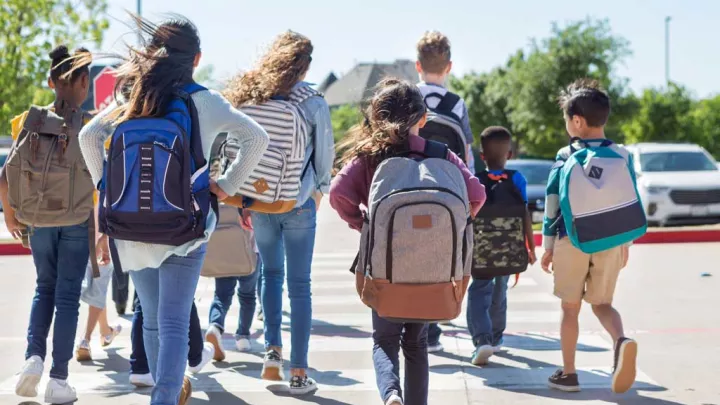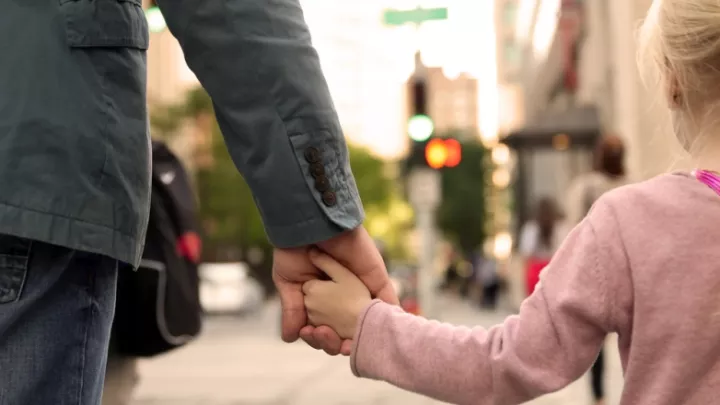
Top Five Back to School Tips for Parents and Kids
Summer is ending and that means no more late nights, sleeping-in, or spending hours playing video games. Instead, it’s time to head back to school where days are filled with classroom lectures and homework.
Sounds dreadful, right? It doesn’t have to. In fact, with a little advance planning, going back to school can be a fun and exciting adventure for kids and parents. The specialists at Children’s Hospital Los Angeles (CHLA) have put together their top five tips to ensure parents and kids transition smoothly from summer vacation to the new school year.
Sleep
Never underestimate the value of a good night’s rest. Sleep is part of the trifecta of healthy must-dos that also includes eating a healthy diet and getting plenty of exercise. Yet working parents and kids often skip on the amount of time they spend sleeping.
“Good sleep enhances what school is all about,” explains Sally L. Davidson Ward, MD, division chief for Pulmonology and medical director for the Sleep Center at CHLA. “It helps kids be more attentive, improves mood and increases one’s ability to learn.” Oftentimes, kids who don’t have a healthy sleep routine are grumpy, unable to concentrate, have behavior difficulties and earn lower grades.
In the long term, poor sleep has consequences including risk for depression, chronic inflammation and a compromised immune system, which may lead to frequent illness, missing school and getting behind in school work.
Some tips to establish a good sleep routine include:
- School-age children (three to 18 years) should strive for an average of nine to 10 hours of sleep each night. Younger kids require an hour or two more each night.
- To help school-age kids transition to the back-to-school schedule, adjust bedtime 15 minutes earlier each night for about a week. During that time, Ward says, “Follow a consistent wakeup schedule every morning and don’t allow any naps during the day so that kids are building up a ‘sleep debt. ‘ This should help create a pattern of falling asleep more quickly and more soundly each night.”
- Another must is limiting screen time on mobile phones, computers, tablets and gaming systems. “The light that’s emitted from the screen is similar to the wavelengths of sunlight serving as a stimulus to offset sleep and stay awake,” Ward explains. “A lot of the activities such as playing video games are stimulating as they require attention and vigilance. This is likely to delay the onset of sleep because the brain is turned on and focused on the activity.” Ward recommends turning off all devices 30-60 minutes before bedtime and keeping devices in a separate room overnight. Reading before bedtime is more calming and a much better way to transition from wakefulness to sleep.
Safety
Children who walk or ride a bike, scooter or skateboard to school are at a greater risk of injury in traffic accidents due to their smaller size, their inability to judge distances and speeds and lack of understanding of traffic laws. It is imperative that children of all ages learn these basic safety rules:
- Always walk on sidewalks or paths whenever possible, and always cross at street corners using traffic signals and crosswalks. If there are no sidewalks, walk facing traffic as far to the left as possible. Even with walk/don’t walk lights at crosswalks, children should be taught to look left, right and left again before crossing the street.
- Make eye contact with drivers before crossing the street, especially if there is no traffic light.
- Children are small and hard to see to drivers. Never cross between parked cars.
- Don’t be a distracted walker. Put phones, headphones and devices down when crossing the street.
- When riding a bike, scooter or skateboard, always wear a properly fitted helmet. It is the best way to prevent head injuries and death. “Make yourself as visible as possible. Be safe and be seen,” says Jeffrey S. Upperman, MD, trauma director at CHLA. “Wear bright colors and use lights and reflective stickers, especially when riding in the morning and at night.”
- Children who take a school bus need to observe additional safety rules. Wait three feet behind the curb until the bus comes to a complete stop before boarding. Always use handrails when going up and down the bus steps. After a long summer, many drivers forget the rules of the road when it comes to school buses. “Follow the speed limit and slow down in school zones and near bus stops. Be alert for kids who may be trying to get to or from the bus,” Upperman says. “Always slow down and stop if you’re driving near a school bus. Flashing yellow lights indicate the bus is preparing to stop and red flashing lights indicate the bus is stopped to allow kids to get on or off.”
Advance Planning
Nobody likes surprises. That’s why it’s helpful for families to create a timeline and a checklist of what needs to be done and by what time. Then, a few days before school starts, begin transitioning to the back-to-school routine by going through a dry run with your kids on a weekday. Get them into a pre-bedtime ritual, followed by a morning run-through of getting dressed, eating breakfast and getting in the car or to the bus stop in time for school.
“Kids should put out their school outfit in their bedroom the night before. They should also place their backpack by the front door and get into bed at their normal school year bedtime,” suggests Stephanie Marcy, PhD, psychologist at CHLA. Treat the next morning like a normal school day. Make sure everyone has breakfast, get lunches ready and then drive the kids to school. “This dress rehearsal exercise will illustrate to kids and parents the amount of time that needs to be allotted to the morning routine,” Marcy says, noting that it is especially helpful for families whose kids go to different schools as it allows parents to navigate the best routes. Most of all, Marcy says, “This will give the child some reassurance of what to expect and make them more familiar with and less anxious about the new school year.” For kids who are attending a new school, especially younger kids, it’s comforting for both the child and the parent to walk in together, take a look around the campus and meet the teacher together.
Another thing that has added to a child's anxiety is smartphones. Marcy says, "Research is demonstrating that there is a rise in anxiety and depression in youth that they are linking directly to smartphone use. I’m seeing a lot more anxiety, a lot more obsessive/compulsive disorder for kids that were naturally anxious and it can be attributed to the constant reminders and availability and access to your social worth, your social value, how many people ‘like’ you."
She recommends that parents need to take control and set up the rules and limitations before their children get their first device. They need to monitor their usage and make it something their child earns and not treated as a right. Find out more on how to handle your child and their smartphone usage: The Link Between Unhappiness and Smartphone Usage with Kids.
Teamwork
Kids and parents often experience some sort of anxiety or stress related to going back to school. Younger kids are often nervous about not knowing any of their classmates. Older kids are often anxious over the amount of homework they will receive each night. Parents are then tasked with managing the kids’ needs with their own schedule, which may include going to work.
“I encourage parents to work up a to-do list and assign tasks to older siblings who can help with getting their younger siblings dressed and fed breakfast before school,” Marcy says. For families with an only child or for single parents, “buddy up with another family and share the task of taking the kids to and from school. When families in the same neighborhood work with each other, coping with the school year feels less daunting.”
Kindness
Kindness is an important part of a child’s development. Kids often model their behavior based on what they see happening at home.
“I encourage parents first, and then other family members to be mindful of how stressful back-to-school can be and to show empathy and not dismiss anyone’s feelings,” Marcy says. “Parents should take the time to speak with their children about their day, what they did and who they met. Instead of saying ‘Oh, you’ll be fine’ or ‘Everything will work out,’ ask your child ‘What are you worried about?’ and then listen to what they say.”
At school kids may be exposed to things they’ve never experienced before. They will see people that look, talk and dress differently than them or may have alternate belief systems. It’s important for parents to help their children learn how to accept people that are different than them and to not look at their differences in a way that is negative or fearful. “Encourage kids to embrace others’ uniqueness and to ask questions so that they can learn more about them. This will teach children not to isolate other children because of their differences.”
For some kids, summer vacation is a respite from negative events they experience at school such as bullying, teasing or social isolation. “Returning to school can provoke a lot of anxiety for them,” Marcy explains. Encourage kids who are being bullied to talk with a teacher or a counselor at school and most important of all, talk to their parents. “A lot of times kids won’t tell their parents about bullying because they are afraid that will make things worse. Parents should assure their kids that they will act responsibly and cooperatively to resolve the unsettling situation.”
What if a parent discovers that their child is the school bully? “Parents should not react by punishing their child so severely that the child is then in a cycle of feeling victimized,” Marcy says. “Instead, talk to the child calmly about the behavior, why they are doing it and how they can stop.” In extreme cases parents may want to consult with their pediatrician or a mental health professional. Sometimes the child’s behavior is a kind of reenactment of something they are experiencing themselves and then using it against another child to make themselves feel more in control,” Marcy says, noting that the most important thing a parent can do is “make sure the child is safe.”


